Tales of Alburquerque's 4S: Shore, Salt, Sweets, and Sacred Past
Happy Friday Hivers!
I often look forward to weekends, not only because I can rest after a week of work, but also to explore different interesting places. My imagination kicks in as the weekend approaches, and that makes me excited.
Just recently, I spent my weekend in Alburquerque, Bohol, which is two towns away from Tagbilaran City. Today, let me tell you a tale about Alburquerque's 4S: Shore, Salt, Sweets, and their Sacred past.

Since I already had my itinerary, everything was all set before the weekend arrived. I planned to wake up early on Saturday because I wanted to leave the house early, but unfortunately, I woke up a little late. So, obviously, I left the house a little late. But it's okay, though, because the weather at that time was gloomy, meaning I wouldn't have to contend with the scorching hot weather.
I went to DAO Bus Terminal in Tagbilaran City, where buses, vans, and jeepneys with different routes can be found. Instead of taking a Ceres bus, I chose to take a jeepney. The fare was just PHP30.00 from the bus terminal to Alburquerque proper.
My first stop was at the ancient church of Sta. Monica. For those who have been following my blog, you know how fascinated I am to explore ancient churches. So this time, I didn't miss the opportunity to see Alburquerque's ancient church.
The Ancient Sta. Monica Church
One can easily find this church as it is situated along the national road. I simply informed the driver to drop me off in front of the church.

As I got closer to the church, I noticed that its paint had already faded, indicating its age and making it easy to tell that it's quite old.

It was very quiet when I arrived inside the compound. I only saw an old lady, but she immediately left after offering a prayer. Once again, I was in awe of their arched facade; it gives an aesthetically pleasing look to the building's exterior. Between the church and the convent, there was a vacant space, and the arches connected these two structures.




After taking photos of the exterior of the building, I was curious to go inside to check its design. So, I headed towards the main door of the church because I thought I could enter from there; however, it was closed.


So, I looked for another door, hoping that it was open. Fortunately, I found an open door on the other side.

I was skeptical about going inside because no one was around, and it was dark. But because of my phone camera's flash, it seemed that the place wasn't dark in the photos. Honestly, I felt a little scared about going in because I was alone. However, due to my eagerness, I found myself inside.
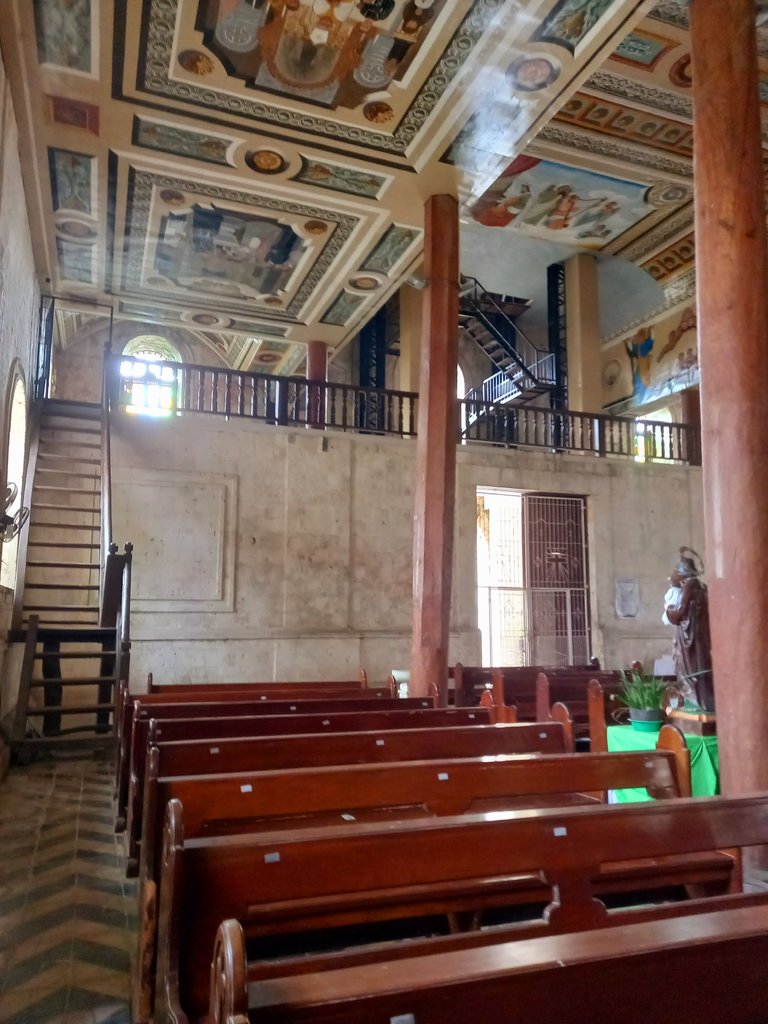
Most of the items inside were already old—the choir loft, the chairs, and the altar. But do you know what amazed me? The structure of the building. It wasn't a cement post that I usually see; it was still made of wood. I truly appreciate the durability of wood because it lasts a long time.

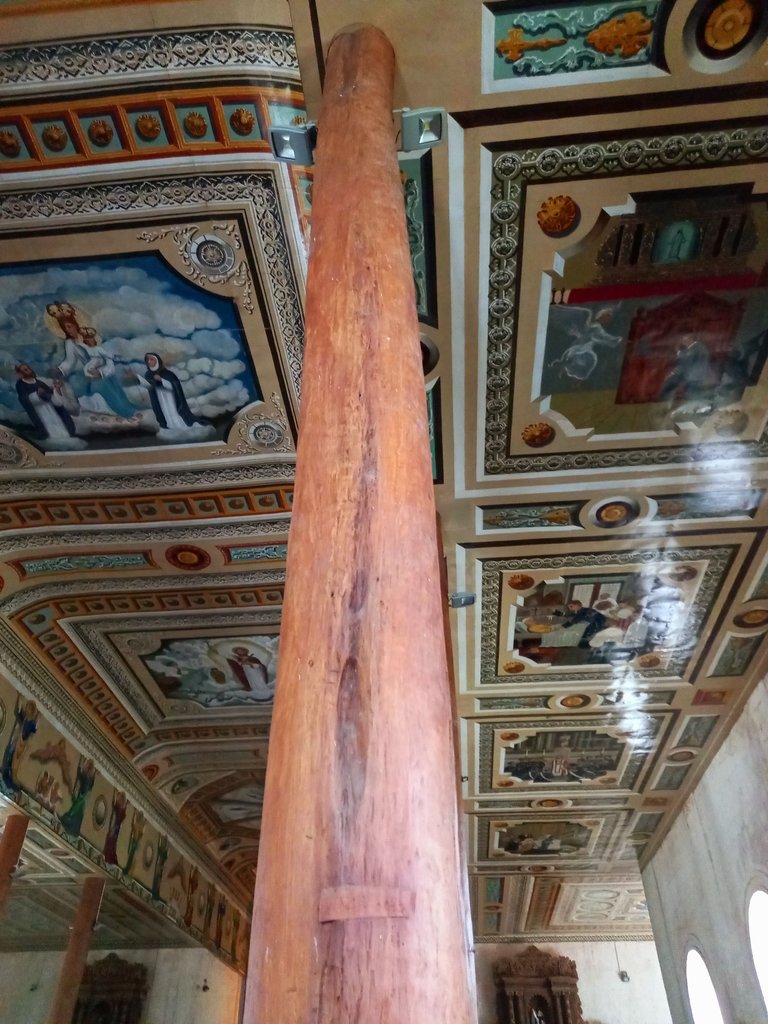


After inspecting the interior, I returned to the front area of the building and noticed the history of the church posted on the wall. I also learned that this church has been declared an important cultural heritage site.
According to the history...
The church began as a visitation chapel of Baclayon under the patronage of Saint Monica. Initially built from wood and bamboo in the western part of the courtyard in 1842. A sturdy and spacious church was constructed in the eastern part in 1856. The location separated from Baclayon and became Alburquerque in 1861. Formally inaugurated as a parish in 1869, it was under the administration of the Recollects until 1898. Father Manuel Muro initiated the construction of the stone church in 1885. The upper part of the walls and the tower were built in the 1920s. Ray Francia painted the ceiling of the church in 1932. The corridor with lined arches connects the church and convent, unique in Bohol.


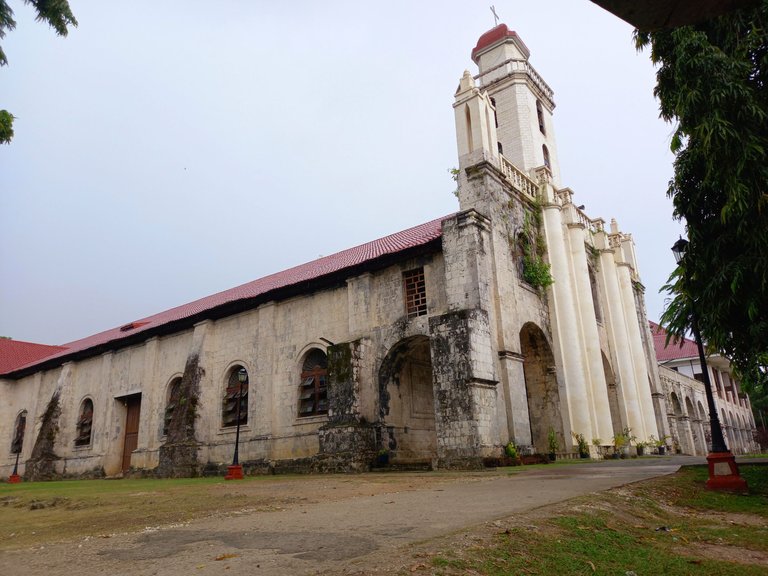
A downpour began when I decided to exit and explore other fascinating places in Alburquerque, so I got stuck at the church compound.

After 30 minutes of downpour, it stopped, and that's when I left the church. By the way, 'BAO' is one of the most convenient transportation options when touring around Alburquerque town. In English, 'bao' means 'turtle,' but I'm not sure why they chose this name—perhaps it's because the appearance is similar to a bao, but I can't say for certain. So, I hired a BAO driver to take me to my next stop, which was to visit Tan Inong's place where 'asin tibuok' production is located.

From Sea to Salt: Exploring the Traditional Asin Tibuok Process
As I had promised in my previous blog, I am sharing my visit to one of the salt-makers in Alburquerque. There was no 'asin tibuok' production at the time I visited; however, the person in charge still explained the process and showed me some of the ingredients they use.
What is asin tibuok?
If translated into English, 'asin' means 'salt,' and 'tibuok' means 'whole.' It is an artisanal sea salt. According to what I have read, this unique 100-year-old traditional Boholano product is exclusively produced in Alburquerque, Bohol, and is considered an endangered cultural knowledge because salt-makers are abandoning the craft due to insufficient compensation. The process takes months, and mastering the skills takes years. Thankfully, the local community has sought to reignite love for this century-old salt-making tradition, especially since it gained popularity online. Asin tibuok is now considered a gourmet pasalubong and the choice salt for chefs. source

We headed to Tan Inong's place to check if they had production of 'asin tibuok' at that time. As we arrived, I noticed that there were many coconut husks in the area, but I didn't pay much attention to it as my intention was to learn about the unique traditional process of making 'asin tibuok,' without knowing that those coconut husks were part of the ingredients used to make it. Amusement was clearly visible on my face.


After soaking in seawater for several days and drying for one day, the coconut husks undergo a heating process until they turn into ashes. According to the person in charge, it takes a few days for all the coconut husks to burn completely.

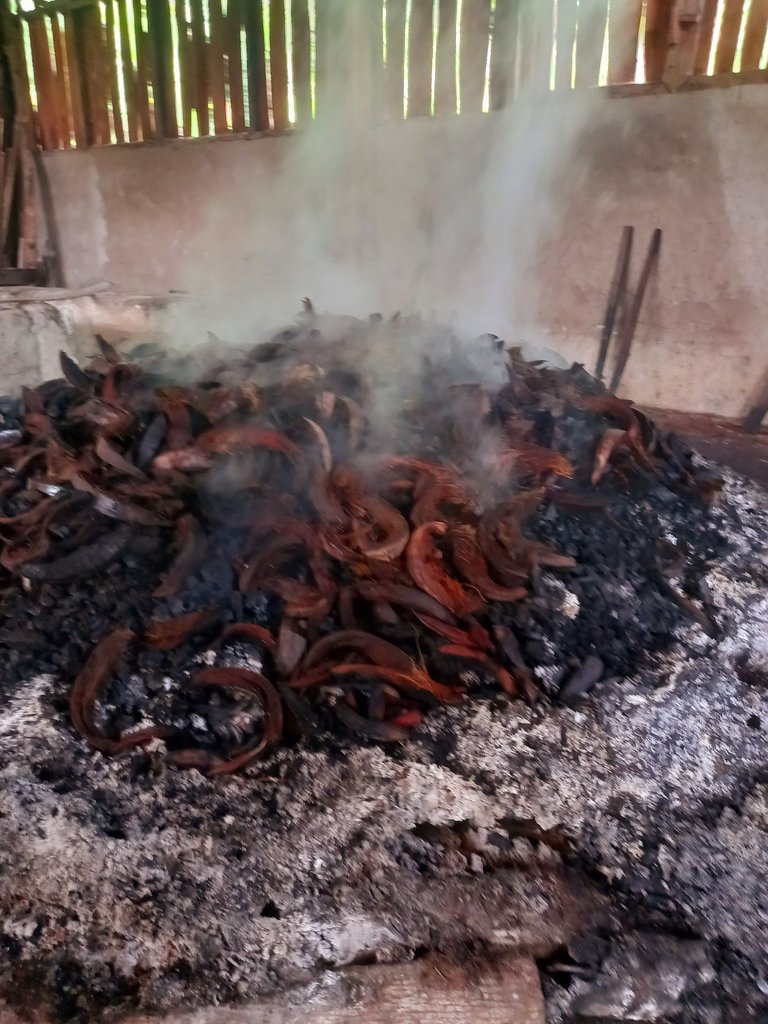
Once it is completely burned, the ashes of burnt coconut husks are mixed with seawater and the funnel is used to filter this mixture.
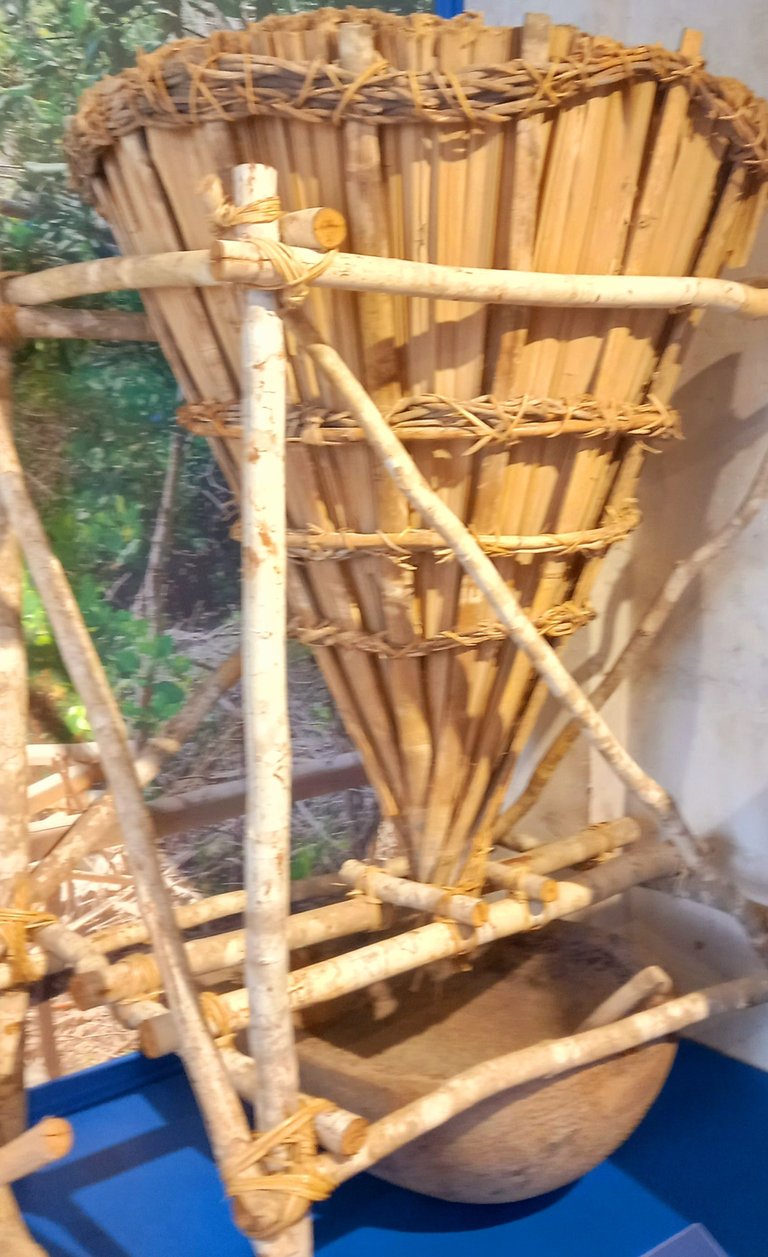
I took a photo of a funnel at the Bohol National Museum. Unfortunately, I forgot to capture the specific funnel they used in the process. During my museum visit, I learned that this type of funnel is used to filter the brine from the ashes of burnt coconut husks.
He also showed me the small pots where the brine is poured before the 7 to 8-hour cooking process.

And this area is where the cooking process takes place.

This is the traditional method of cooking 'asin tibuok'.

The photo above is not mine. source
Since they didn't have any stock of their products, I used my own photos taken during my museum visit. This is what 'asin tibuok' looks like, and it is priced at PHP 800.00 each. I don't question why it is expensive because the traditional process of making 'asin tibuok' is indeed a lengthy one. It requires a lot of patience and hard work.

After exploring the production of 'asin tibuok,' I asked the bao driver to take me to Sta. Fe Beach. When I inquired if they had a beautiful beach, his reply was, 'Our beach here is not nice.' Despite his negative response, I still decided to visit their beach. Mangrove swamps greeted us as we approached the beach. What I thought at that time was that maybe he was right; they didn't have a nice beach due to the presence of mangroves.
The Beautiful Lie: Showcasing the Sta. Fe Pristine Beach
Cottages immediately caught my attention as we arrived. While walking toward the beach, I noticed children enjoying themselves. Initially, I agreed with the driver, as I hadn't seen the whole beach yet.




I continued walking until the stunning beauty of the beach left me in awe. A smile was painted on my face, realizing that the driver's statement about the beach not being nice was indeed a beautiful lie.
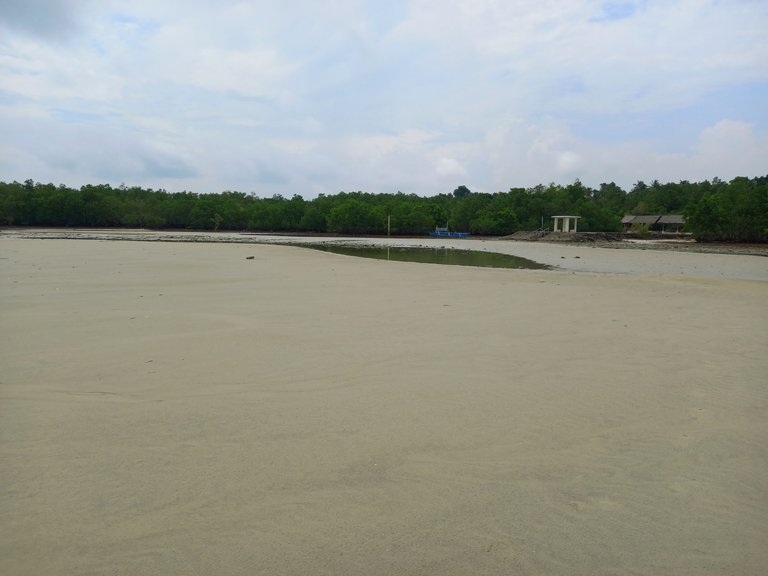

While strolling at the beach, I didn't mind the time; I just savored the moment with the beautiful scenery. The driver told me that my visit was perfect because it was low tide, allowing me to see the beach and its white sand.


There was a long stretch of sandbar farther away, but I didn't have the courage to go there since I didn't have a companion, and no one was around. Not being sure if that area was safe, I contented myself with seeing it from afar. If only there were people there, I would have surely gone to that area.


Since the weather turned erratic, the temperature increased after a heavy rain, prompting me to decide to leave the beach area.



When I reached the parking area, I immediately confronted the driver about the misinformation he provided. He simply smiled and shared that, in his view, the beach wasn't beautiful. He didn't realize that, for me, they were fortunate to have such a stunning beach.

After enjoying my time at the beach, we headed to my last stop to the place where the calamay production is located.
Sweet Treats: Showcasing the Well-Known Calamay
When you mention 'calamay,' people from neighboring islands immediately recognize it as a sweet delicacy from Bohol island. It's made of sticky rice, sugar, and coconut cream. If you're a fan of sweet treats, you'll definitely enjoy it. The taste is simply delicious.

The driver took me to one of the calamay makers in town. Fortunately, they allowed me to enter their production area. They were nearly done making calamay by the time I arrived. I noticed coconut shells on the table, as they were to be used for placing the calamay.

And here is the freshly cooked calamay on the coconut shell.



If someone prefers not to have calamay in a coconut shell, they also offer calamay in a plastic container.

The price varies based on the size of the coconut shell. I chose the small one, so I paid PHP 140.00 for 2 calamay servings in coconut shells.

Alburquerque is just a small town, but it has much to offer to tourists. These were the experiences I had during that weekend, and I can say it was full of learning and discoveries. That concludes my tale about Alburquerque's 4S (Shore, Salt, Sweets, and Sacred Past)
Thank you for reading and see you on my next blog. Cheers!
Watch with glittering eyes the whole world around you because the greatest secrets are always hidden in the most unlikely places.
Discord: kellyane#0924
Note: I use Grammarly to help me check and fix grammar.


Namaste! I am fond of reading books, watching korean, american and filipino series/movies and I am also fond of gardening. I love listening to different life stories and I am always captivated with the beauty of nature so travel is my escape when life turns into blue. But hey, how could I forget my photography hobby? It is one of the best, so follow me as I will be featuring my experiences of the stuff that I am passionate with.
Congratulations, your post has been added to Pinmapple! 🎉🥳🍍
Did you know you have your own profile map?
And every post has their own map too!
Want to have your post on the map too?
I didn't know about Asin Tibook so it's fascinating to know about it. I miss Calamay from Bohol! And wait, the church doesn't look like it got affected by the great earthquake years ago. Or was it?
The Alburquerque Church was also affected during the 2013 earthquake, but according to the locals, the church had only minimal damage, unlike the other ancient churches in Bohol.
I also didn't know about asin tibuok until I explored Bohol island by myself. Lami ra gihapon ang calamay @wittyzell.😁
Thanks for dropping by.
This post has been manually curated by @steemflow from Indiaunited community. Join us on our Discord Server.
Do you know that you can earn a passive income by delegating to @indiaunited. We share more than 100 % of the curation rewards with the delegators in the form of IUC tokens. HP delegators and IUC token holders also get upto 20% additional vote weight.
Here are some handy links for delegations: 100HP, 250HP, 500HP, 1000HP.
100% of the rewards from this comment goes to the curator for their manual curation efforts. Please encourage the curator @steemflow by upvoting this comment and support the community by voting the posts made by @indiaunited.
Whoa, i'm so jealous that you could so this alone and on your own. Ako kasi I always want my Mama accompanied me in every travel, takot maligaw ba, lol. But doing this, like traveling alone, exploring the town on your own sounds more awesome and cool and mas dama mo yong adventure ee. I hope magawa ko to soonest, uwu.
Anyways, this is a wonderful travel and walk as you see a lot thanks to you, we also see them here and I enjoyed it too.
My favorite part was the beach with its white sand. I feel like running around in that area bare footed will really feel good.
Alam mo ba na mas ok yung maligaw. 😁
Try mo lang ppng gumala sa nxt town nyo na mag-isa kung takot ka pang gumala sa malayung lugar.
Haha, coz marami madidiscover on thr way? Uwu
Let see, maybe magagawa ko din to one day.
WOW! What a mesmerizing place to be in
Thank you.
Kanindot jud sa Bohol. Murag bisan asa ka padulong naay something interesting to discover and do. Nindota sa white sand. Maka ❤️❤️
Kada lungsod mem naay mga nice spots 😁
3in1 maka laag bah. Murag napungot😂.
Lahi rapod ilang asin diha. Dali ra madugmok girl ilang asin or etuslob ang tibuok kung magtimpla?
Gamitan man na nila ug kutsilyo gurl.
From visiting ancient church - to asin tibuok production place to - to beach laag ...... nindota sa adventure uyyy! 😍😍 Murag daghan aninikad ug tuway diha nga beach jack da hahaha! Ug ganahan ko kay murag peaceful ug relaxing kaayo.
Maka SSSS jud jack- Suya-SoMuch-Si-SelfNako(napud) hahaha!
Daghan tuway day 😁😁
Halaaaaaaaaa ganahan ko ana 😭😭 SSSSuyaa jud nako ba hahahahaha